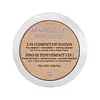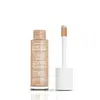Marcelle Skincaring 3-In-1 Compact Foundation Versus Marcelle Skincaring 2-In-1 Soothing Foundation + Concealer
What's inside
What's inside
 Key Ingredients
Key Ingredients

 Benefits
Benefits

 Concerns
Concerns

 Ingredients Side-by-side
Ingredients Side-by-side

Mica
Cosmetic ColorantSynthetic Fluorphlogopite
Dimethicone
EmollientZinc Myristate
Silica
AbrasiveTriethoxycaprylylsilane
Niacinamide
SmoothingSqualane
EmollientLactobacillus Ferment
Skin ConditioningSodium Hyaluronate
HumectantEthylhexylglycerin
Skin ConditioningMaltodextrin
AbsorbentSodium Dehydroacetate
PreservativeSorbic Acid
PreservativeTocopherol
AntioxidantCI 77891
Cosmetic ColorantCI 77492
Cosmetic ColorantCI 77491
Cosmetic ColorantCI 77499
Cosmetic ColorantWater
Skin ConditioningCyclopentasiloxane
EmollientGlycerin
HumectantPropanediol
SolventC12-15 Alkyl Benzoate
AntimicrobialAluminum Starch Octenylsuccinate
AbsorbentPEG/PPG-18/18 Dimethicone
EmulsifyingMica
Cosmetic ColorantHexyl Laurate
EmollientCetyl PEG/PPG-10/1 Dimethicone
EmulsifyingPolyglyceryl-4 Isostearate
EmulsifyingIsododecane
EmollientHylocereus Undatus Fruit Extract
Skin ConditioningCentella Asiatica Leaf Extract
Skin ConditioningTocopheryl Acetate
AntioxidantDisteardimonium Hectorite
StabilisingSodium Chloride
MaskingTrihydroxystearin
Skin ConditioningTriethoxycaprylylsilane
Propylene Carbonate
SolventAcrylates/Dimethicone Copolymer
Skin ConditioningDisodium EDTA
Sodium Hyaluronate
HumectantCitric Acid
BufferingXanthan Gum
EmulsifyingSodium Metabisulfite
AntioxidantPhenoxyethanol
PreservativeCI 77891
Cosmetic ColorantCI 77492
Cosmetic ColorantCI 77491
Cosmetic ColorantCI 77499
Cosmetic ColorantWater, Cyclopentasiloxane, Glycerin, Propanediol, C12-15 Alkyl Benzoate, Aluminum Starch Octenylsuccinate, PEG/PPG-18/18 Dimethicone, Mica, Hexyl Laurate, Cetyl PEG/PPG-10/1 Dimethicone, Polyglyceryl-4 Isostearate, Isododecane, Hylocereus Undatus Fruit Extract, Centella Asiatica Leaf Extract, Tocopheryl Acetate, Disteardimonium Hectorite, Sodium Chloride, Trihydroxystearin, Triethoxycaprylylsilane, Propylene Carbonate, Acrylates/Dimethicone Copolymer, Disodium EDTA, Sodium Hyaluronate, Citric Acid, Xanthan Gum, Sodium Metabisulfite, Phenoxyethanol, CI 77891, CI 77492, CI 77491, CI 77499
Ingredients Explained
These ingredients are found in both products.
Ingredients higher up in an ingredient list are typically present in a larger amount.
Ci 77491 is also hydrated iron III oxide. It's sole purpose is to give a red/pink hue to products.
Iron III oxides are classified as inorganic chemicals for coloring.
Synthetically created Ci 77491 is considered safer than those naturally found. This is because the synthetically created version may contain less impurities. Iron oxides are generally non-toxic and non-allergenic.
Learn more about CI 77491Ci 77492 is also hydrated iron III oxide. It's sole purpose is to give a yellow hue to products.
Iron III oxides are classified as inorganic chemicals for coloring.
Synthetically created Ci 77492 is considered safer than those naturally found. This is because the synthetically created version may contain less impurities. Iron oxides are generally non-toxic and non-allergenic.
Learn more about CI 77492Ci 77499 is also hydrated iron III oxide. It is created from mixing red and black iron oxides. This helps give shades of darkness to a product.
Iron III oxides are classified as inorganic chemicals for coloring.
Ci 77891 is a white pigment from Titanium dioxide. It is naturally found in minerals such as rutile and ilmenite.
It's main function is to add a white color to cosmetics. It can also be mixed with other colors to create different shades.
Ci 77891 is commonly found in sunscreens due to its ability to block UV rays.
Learn more about CI 77891Mica is a naturally occurring mineral used to add shimmer and color in cosmetics. It can also help improve the texture of a product or give it an opaque, white/silver color.
Serecite is the name for very fine but ragged grains of mica.
This ingredient is often coated with metal oxides like titanium dioxide. Trace amounts of heavy metals may be found in mica, but these metals are not harmful in our personal products.
Mica has been used since prehistoric times throughout the world. Ancient Egyptian, Indian, Greek, Roman, Aztec, and Chinese civilizations have used mica.
Learn more about MicaSodium Hyaluronate is hyaluronic acid's salt form. It is commonly derived from the sodium salt of hyaluronic acid.
Like hyaluronic acid, it is great at holding water and acts as a humectant. This makes it a great skin hydrating ingredient.
Sodium Hyaluronate is naturally occurring in our bodies and is mostly found in eye fluid and joints.
These are some other common types of Hyaluronic Acid:
Learn more about Sodium HyaluronateTriethoxycaprylylsilane is a silicone used to bind and stabilize ingredients.
As an emulsifier, it helps prevent ingredients from separating. This can help elongate the shelf life of products.
Triethoxycaprylylsilane is often used to coat mineral sunscreens ingredients to help give a better feel. It also helps reduce oxidative stress in sunscreens.
Learn more about Triethoxycaprylylsilane